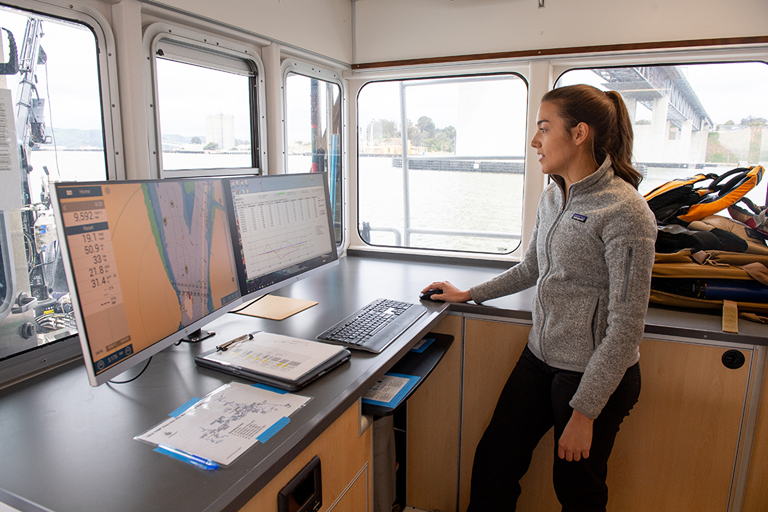DWR Women Scientists Highlight Field Work, Careers in Social Media Takeover
Image of Morgan Battey conducting field work on DWR’s research vessel, The Sentinel. Courtesy photo.
DWR environmental scientists – Morgan Battey, Vanessa Velasco, and Chelsea Palisoc – shared their diverse contributions to protecting the environment in a week-long Instagram takeover as part of Women in Science Week.
In Morgan Battey’s takeover, she posted a video of how sampling is done for the veliger monitoring program to detect and prevent the spread of quagga and zebra mussels. This video became the most viewed video ever on DWR’s Instagram channel. She also shared photos that featured her collecting discrete water quality measurements in the Delta during her field work on DWR’s research vessel, The Sentinel.
For Morgan, who is an Environmental Scientist in the Division of Integrated Science and Engineering, she enjoys being an environmental scientist at DWR because she can be involved in a variety of different projects and work with so many inspiring individuals who truly care about their role in California's water system.
While doing her postings, Morgan shared that young women who are interested in science should not believe the myth that you can’t be a scientist unless you develop groundbreaking research.
“Good science doesn’t necessarily rely on one brilliant mind continuously making amazing discoveries,” said Morgan. “Instead, it relies on many minds that all think very differently and bring something different to the table. You could one day be the person that provides a fresh new outlook to a team looking for creative solutions. So, if you're on the fence, I'd encourage you to take the leap!”
As a Senior Environmental Scientist with the Division of Regional Assistance’s Southern Region Office in Glendale, Vanessa Velasco ensures DWR meets its mission to address climate change and resiliency efforts within it programs and projects. Her assignment allows her to support local water agencies in Southern California by incorporating climate change into their planning efforts.
Vanessa posted photos of her work in the field with the California Department of Fish and Wildlife on a Desert Pupfish relocation at the Salton Sea.
“The field of science is so expansive and filled with unique opportunities,” said Vanessa. “You are bound to find a space that’s gratifying and makes you feel accomplished. Pursuing science helped me better understand how the biological world works and how I can be an influential steward of the environment.”
Chelsea Palisoc, an Environmental Scientist in the Division of Regional Assistance, is part of the Riverine Stewardship Program, where she works on the San Joaquin Fish Population Enhancement Program and the Urban Streams Restoration Program. Through her work on several creek and river restoration projects Chelsea has helped in reducing flood risk and enhancing habitat for native fish and bird species.
“I'm so thankful to be where I am and the opportunities that I have within DWR toward my goal of creating accessible, efficient, multi-benefit riverine projects that restore ecosystem functionality, empower the local community, and promote inclusivity,” said Chelsea. “I'm proud to be a female in the science field and I hope that I can be a great role model for the next generation to follow.”
In addition to inspiring others to consider a career in science, the multiple online postings boosted DWR’s social media platforms with 141 new followers on LinkedIn, 581 engagements on Twitter, and 971 Facebook page visits.
